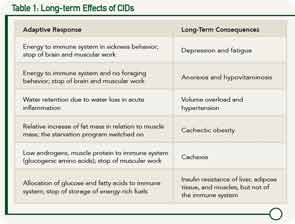Local inflammation, he said, needs mainly local fuels, and systemic energy is not needed. Sometimes, however, cytokines, activated immune cells, and sensory nervous signals spill over and induce an energy appeal reaction that enforces a systemic energy supply.
Local inflammation needs mainly local fuels, and systemic energy is not needed. Sometimes, however, cytokines, activated immune cells, and sensory nervous signals spill over and induce an energy appeal reaction that enforces a systemic energy supply.
Analyzing the Systemic Response
Using concepts from evolutionary medicine, he then introduced the idea that the neuroendocrine immune network has been positively selected to serve short-lived inflammation (e.g., infectious diseases). He rejected the notion that genes have been positively selected for CIDs over time and emphasized that the genes linked to rheumatic diseases (such as HLA DR4) are for short-lived inflammatory reactions (for example, to overcome Dengue hemorrhagic fever).
According to Dr. Straub’s theory, interactions of the immune, nervous, and endocrine systems are necessary for energy and volume regulation and are positively selected for acute short-lived inflammation.
In systemic disease sequelae of CIDs, he said, important adaptive programs are switched on to support acute, but not chronic, energy-consuming inflammation, and this has desolate consequences for the rest of the body.
“When inflammation occurs, the immune system is demanding energy-rich fuels and stops the other supersystem. This demand reaction has been positively selected to overcome infectious diseases,” he said. “Long-term use of the demand reaction leads to unwanted disease sequelae in chronically inflamed patients.”
He walked participants through a number of examples to illustrate these desolate consequences or disease sequelae of CIDs when adaptive programs are switched on over the long term (see Table 1).
Energy Demand: The Unifying Concept
These examples of disease sequelae of CIDs highlight the central theme of Dr. Straub’s hypothesis. “Energy homeostasis is the common denominator of the systemic disease sequelae in chronic inflammatory disease,” he said.
He ended his talk by highlighting data that show that even slight increases in serum IL-6 elevates energy expenditure and starts the energy appeal reaction in humans, and that gradual increases in serum IL-6 occur naturally as people age. In people with chronic inflammatory diseases, however, this gradual increase is escalated and results in accelerated aging and premature age-related diseases.
For Dr. Straub, the new model or hypothesis emphasizes the importance of inflammation and controlling it. His key message to clinicians: “Keep inflammation as low as possible in order to stop the energy-demanding immune system,” he said, with the desired aim to achieve a C-reactive protein target in the normal range.
